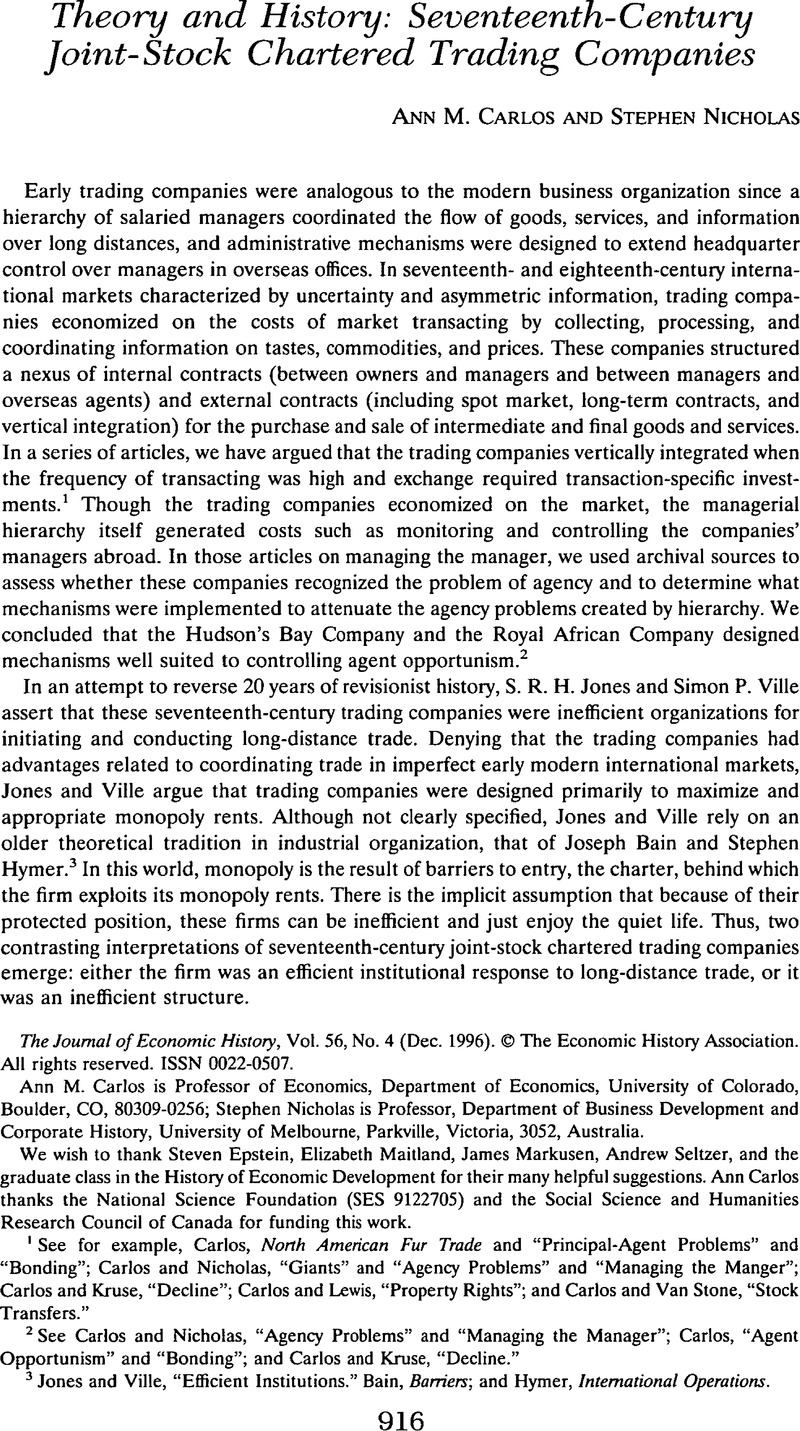Crossref Citations
This article has been cited by the following publications. This list is generated based on data provided by Crossref.
Zahedieh, Nuala
1999.
Making Mercantilism Work: London Merchants And Atlantic Trade in the Seventeenth Century.
Transactions of the Royal Historical Society,
Vol. 9,
Issue. ,
p.
143.
Carlos, Ann M.
Moyen, Nathalie
and
Hill, Jonathan
2002.
Royal African Company Share Prices during the South Sea Bubble.
Explorations in Economic History,
Vol. 39,
Issue. 1,
p.
61.
Müller, Leos
2003.
The Swedish East India trade and international markets: Re-exports of teas, 1731–1813.
Scandinavian Economic History Review,
Vol. 51,
Issue. 3,
p.
28.
Gelderblom, Oscar
2003.
The Governance of Early Modern Trade: The Case of Hans Thijs, 1556–1611.
Enterprise and Society,
Vol. 4,
Issue. 4,
p.
606.
Gelderblom, Oscar
2003.
The Governance of Early Modern Trade: The Case of Hans Thijs, 1556–1611.
Enterprise and Society,
Vol. 4,
Issue. 4,
p.
606.
Greif, Avner
2005.
Handbook of New Institutional Economics.
p.
727.
Harris, Ron
2005.
The Formation of the East India Company as a Cooperation-Enhancing Institution.
SSRN Electronic Journal,
Erikson, Emily
and
Bearman, Peter
2006.
Malfeasance and the Foundations for Global Trade: The Structure of English Trade in the East Indies, 1601–1833.
American Journal of Sociology,
Vol. 112,
Issue. 1,
p.
195.
Greif, Avner
2008.
Handbook of New Institutional Economics.
p.
727.
Boldorf, M.
2009.
Socio-economic institutions and transaction costs: merchant guilds and rural trade in eighteenth-century Lower Silesia.
European Review of Economic History,
Vol. 13,
Issue. 2,
p.
173.
Stern, Philip J.
2009.
History and Historiography of the English East India Company: Past, Present, and Future!.
History Compass,
Vol. 7,
Issue. 4,
p.
1146.
Walker, Paul
2012.
The Past and Present of the Theory of the Firm.
SSRN Electronic Journal,
Solar, Peter M.
2013.
Opening to the East: Shipping Between Europe and Asia, 1770–1830.
The Journal of Economic History,
Vol. 73,
Issue. 3,
p.
625.
Dari-Mattiacci, Giuseppe
Gelderblom, Oscar
Jonker, Joost
and
Perotti, Enrico C.
2013.
The Emergence of the Corporate Form.
SSRN Electronic Journal,
Sivramkrishna, Sashi
2014.
From merchant to merchant-ruler: A structure–conduct–performance perspective of the East India Company's history, 1600–1765.
Business History,
Vol. 56,
Issue. 5,
p.
789.
Erikson, Emily
and
Assenova, Valentina
2015.
Chartering Capitalism: Organizing Markets, States, and Publics.
Vol. 29,
Issue. ,
p.
1.
Economou, Emmanouil M.L.
and
Kyriazis, Nicholas C.
2016.
Choosing Peace Instead of War. A Lesson from Athenian Democracy.
Peace Economics, Peace Science and Public Policy,
Vol. 22,
Issue. 2,
p.
191.
Rönnbäck, Klas
2016.
Transaction costs of early modern multinational enterprise: measuring the transatlantic information lag of the British Royal African Company and its successor, 1680–1818.
Business History,
Vol. 58,
Issue. 8,
p.
1147.
Leng, Thomas
2016.
Interlopers and disorderly brethren at the Stade Mart: commercial regulations and practices amongst the Merchant Adventurers of England in the late Elizabethan period.
The Economic History Review,
Vol. 69,
Issue. 3,
p.
823.
Economou, Emmanouil-Marios L.
Kyriazis, Nicholas
and
Metaxas, Theodore
2017.
Democracy and an Open-Economy World Order.
p.
147.



